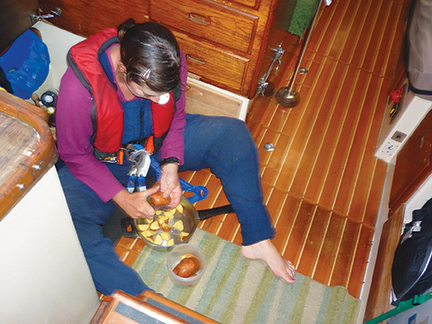There is nothing like a hot meal at the end of a hard day of sailing, especially on passage. (published August 2015)
It is not always easy or comfortable, but no matter how long we are at sea or how bad the conditions are I try to serve at least one hot bowl a day. It takes a bit of water under the keel to understand how both you and the galley work while sailing. But whether you are planning a three day or three week passage, the strategies for cooking and serving hot meals at sea are the same.
BE PREPARED
Passages require planning, and part of that preparation should be a meal plan. You need to know approximately how long you’ll be at sea, how many crew will be on board and any dietary requirements or allergies. Armed with this information, you can plan and provision for the trip.
Whether you’re coastal cruising or doing blue water passages it is helpful to know what kind of conditions you can expect. Not even the meteorologist is right all the time but gathering the forecast, the predicted wind, seas, tides and general topography of where you’re sailing will give you some indication of what to anticipate.
I always take advantage of time in port before departure to cook a few meals for the passage. Knowing that the boat will be in motion, I make food that can be served in a bowl and eaten with a single utensil. This saves on spills, but more importantly, always leaves a hand free to brace and steady yourself as you move about the boat.
This doesn’t mean that food has to be boring, it just has to be practical. A hearty stew, meatballs that can be heaped over rice, a sweet and sour stir fry that can be served over quick cooking noodles and a flavor-packed vegetarian curry are all meals I have cooked ahead of time for passage. Ingredients are diced into bite-sized chunks and nothing requires a knife or is too saucy. When the sea is particularly boisterous, I serve in sturdy plastic containers that have positive locking lids. Since we most often eat in the cockpit, a tight cover keeps the food hot and transportation easy. And if a crew member has to put dinner down to make a course adjustment or grind a winch there is no need to be worried about it sliding out of the bowl and making a mess.
A vacuum packer is an invaluable tool for pre-passage cooking. Properly sealed and free from air, food will keep without spoiling for several days, buying you more time in the fridge and less time in front of a moving stove. I like to keep a couple of aces in my apron pocket on long passages, in case conditions deteriorate and standing beside an open pot becomes precarious. Vacuum bags can be frozen, boiled, and even put in a pressure cooker. A precooked and vacuum packed main meal can be heated in the bag in the five minutes it takes to cook rice or potatoes in a pressure cooker. This means you can squirrel away meals for those rough days when wrapping your hands around a steaming hot bowl at dinner time is as much a balm for the soul as energy for a weary body.
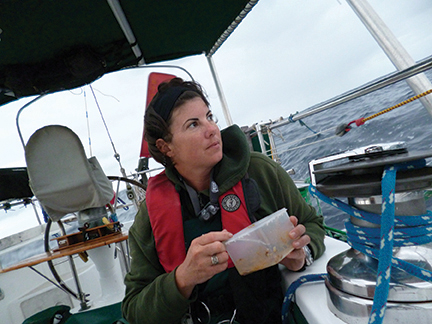
With the meals for the first night or two already prepared, you will be able to acclimatize to the motion of the boat underway, this is especially important if you haven’t been at sea for a while or suffer from sea sickness. Planning ahead and giving yourself this much needed break could mean the difference between nourishing your body and feeding the fishes.
CHOOSE THE RIGHT INGREDIENTS
While underway my galley is stripped down to its basic elements. Stowed are the six varieties of hot sauce that regularly populate the countertop, and gone is the random dirty dish that always seems to be left in the sink. There is nothing left out that could become a potential projectile and nothing is hastily shoved out of sight so that it will tumble out when a cupboard is opened at sea. The galley becomes pure of function.
A gimballed stove with good fitting rails and fiddles is your best friend when it comes to cooking underway. This allows for the cooking surface to stay flat when the boat heels and the pots to stay securely on the stove top if the boat rolls unexpectedly. If you have a new model boat or stove, these two things come standard. But if you’re like me and have a stove that is no longer in production, you might have to think outside the pot, so to speak, to make the stove a safer place to be underway. I’ve scrounged fiddles from abandoned stoves in boatyards until I had a mismatched set that was up to the task and had a lock installed on the oven door and the railings modified. These changes have made a tremendous difference; I can now momentarily step away from the stove without worrying about getting injured when a pot slips off the burner or being victim of a phantom food fight. Invest the time, and if necessary money, to make your stove a functioning piece of equipment at sea. It will make cooking easier and safer.
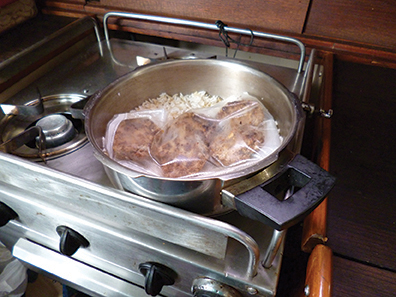
Standing in front of a hot stove, concentrating on the task at hand while the boat heaves and pitches, can make even the heartiest sailor feel a little ill. To cut down on time in the galley I use a pressure cooker most of the time I cook underway. Dinner is ready in record time and with its securely locking lid it ensures that the meal will end up in the bowl not on the floor. But one-pot-wonders can get boring and sometimes a standard pot or frying pan is called for. Choosing a pot that is a little larger than necessary gives food plenty of room to slop around without jumping out of the pan, and making sure pots and pans used at sea have properly fitted lids and heat proof handles will reduce risk of accidental burns or scalds.
FOLLOW THE RECIPE
The stove may be gimballed but the countertops are not, which can make even the easiest dinner prep a difficult activity. When working down below stand with your feet wide, this will give you better balance and stability. Work slowly and with the rhythm of the boat, and never leave cupboards doors ajar or drawers open, it only takes one mistimed wave to empty the shelves and create a huge mess.
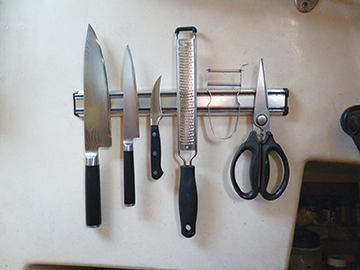
When doing dinner prep, have all the necessary tools, bowls and pots at hand and secured, either with rubber feet or on a piece of non-skid. Knives are a necessity in any galley but can easily become a serious hazard if left on a countertop while sailing. A great to way to secure knives is with a magnetic knife strip. Mounted on a bulkhead it will not only protect your blades but will keep even heavy knives secure at sea. When you’re up to your elbows and you’re running out of counter space don’t forget about the galley sink. It is a great catch all and quick way to secure dirty dishes, a hot pot or a sharp knife.
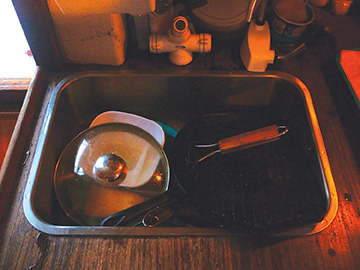
If the movement of the boat is too erratic, clean a space on the floor and work sitting down. Or take a small cutting board and paring knife out to the cockpit while on watch and do all the chopping and slicing al fresco, scraps can get tossed directly overboard, sea water can be used for cleanup and fresh air prevents feelings of sickness. Don’t forget that heaving to is also an option, giving you a break to cook and eat. Cooking underway is not a timed event, nor is it a solo sport, so divide the work load, don’t rush and ease the stress come meal time.
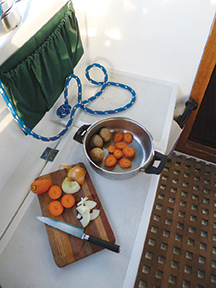
SAFETY FIRST
Sometimes it feels like cooking underway requires four hands; two to deal with the meal and two more to keep stable and upright. The standard “U-shaped” galley was designed to be practical, not necessarily spacious. With everything within arm’s reach and lots of places to brace yourself, most galleys are pretty comfortable. That said, designers are not always users, so if you are constantly reaching for a handhold that is not there, install one. Mine doubles as a place to hang a dish towel.
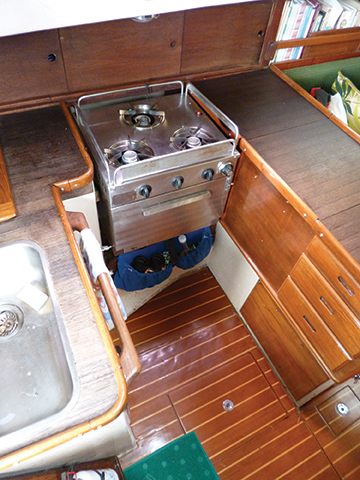 Cutting pieces of non-skid to fit countertops is a common sense way to keep dishes and cutlery from flying around the cabin. Having a mat in the galley that will stay dry and has traction will keep you on your feet and hopefully free of bruises. Some people like to use a galley strap, a type of support that hugs the waist and is clipped to a strong point near the stove. Although I can see the attraction since they prevent you from falling over, they also limit movement. If a pot decides to leap off the stove and you are tethered close to it, you may not be able to move out of harm’s way. In that situation you wouldn’t just be left with egg on your face, you could suffer serious burns and medical help is most likely several days away.
Cutting pieces of non-skid to fit countertops is a common sense way to keep dishes and cutlery from flying around the cabin. Having a mat in the galley that will stay dry and has traction will keep you on your feet and hopefully free of bruises. Some people like to use a galley strap, a type of support that hugs the waist and is clipped to a strong point near the stove. Although I can see the attraction since they prevent you from falling over, they also limit movement. If a pot decides to leap off the stove and you are tethered close to it, you may not be able to move out of harm’s way. In that situation you wouldn’t just be left with egg on your face, you could suffer serious burns and medical help is most likely several days away.
When I cooked professionally on yachts, I was constantly reminded that the galley was one of the biggest fire hazards on the vessel. A small sailboat is no different, so make general safety checks part of the regular routine. Inspect gas hoses that run through compartments and behind the stove for signs of chafe every couple of months. This is especially important if the unit is gimballed and used underway often. Install fire extinguishers in easy to reach places and make sure everyone onboard is familiar with how to use them. And a fire blanket is an inexpensive but extremely effective way to douse accidental flare-ups.
Cooking underway involves open flame burners, sharp knives, pots of scalding hot liquids and unpredictable seas, but that doesn’t mean it is a recipe for disaster. With a well-appointed galley, some pre-passage planning and a safety conscious cook, everyone can enjoy healthy, hot meals at sea.
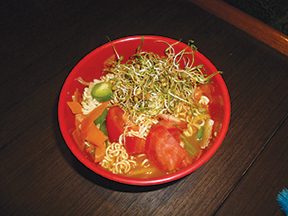
Heather Francis is from Nova Scotia, Canada and for over a decade has worked and lived on boats throughout the world. In 2008 she and Steve, her Aussie partner, bought Kate, a Newport 41′, and have been sailing ever since. They are planning to do a lap around the planet, albeit slowly. To follow their adventures log onto www.yachtkate.com
FIVE HOT TIPS
•••If it looks like you’re in for some bad weather take the opportunity before conditions get too uncomfortable to cook a meal or two; it is easier to reheat leftovers when it is rough then make a meal from scratch.
•••Instant noodles are great in a pinch, but ditch the chemical laden flavor pack. Instead use a MSG free stock cube or some miso soup broth, add some thinly sliced veggies and leftover meat or tofu and you’ve got a healthy, hot meal ready in minutes!
•••Pasta can be pre-cooked. Simply cook al dente, drain and rinse with fresh water and drain again. Toss lightly in oil and store in an air tight container in the fridge. To serve pour boiling water over cooked noodles to reheat.
•••A hot breakfast is quick and easy. Instant oatmeal with fruit preserves or instant grits with a hardboiled egg, (I always keep a half a dozen in the fridge on passage).
•••To avoid spills and make the morning easy store sugar, instant coffee and hot chocolate in squeeze bottles. And when you boil the kettle make sure to fill a thermos so you can have hot drinks later without lighting the stove.
















